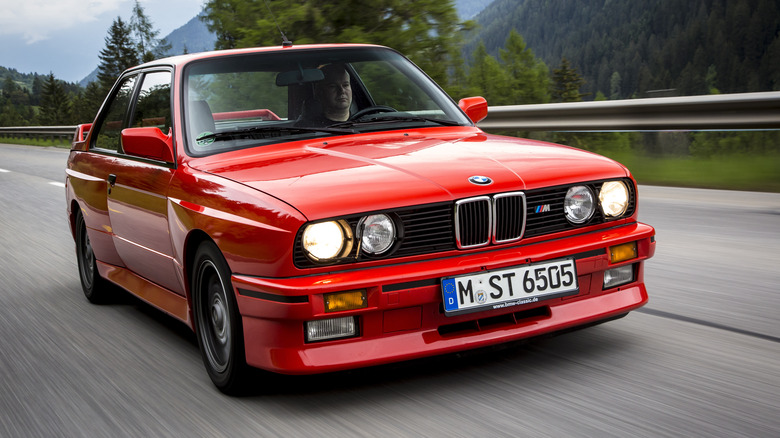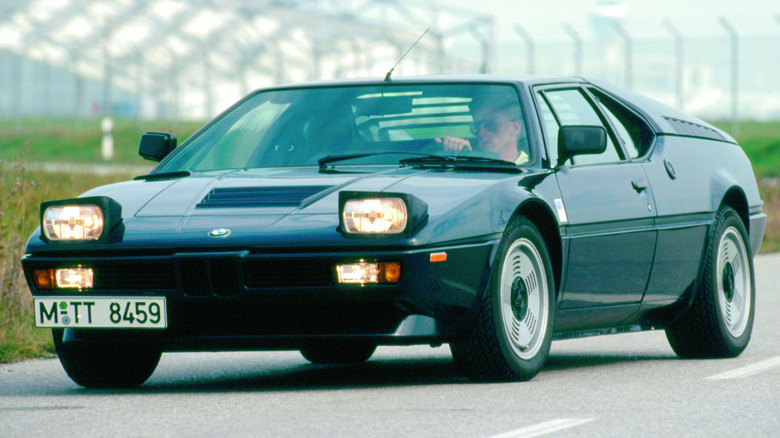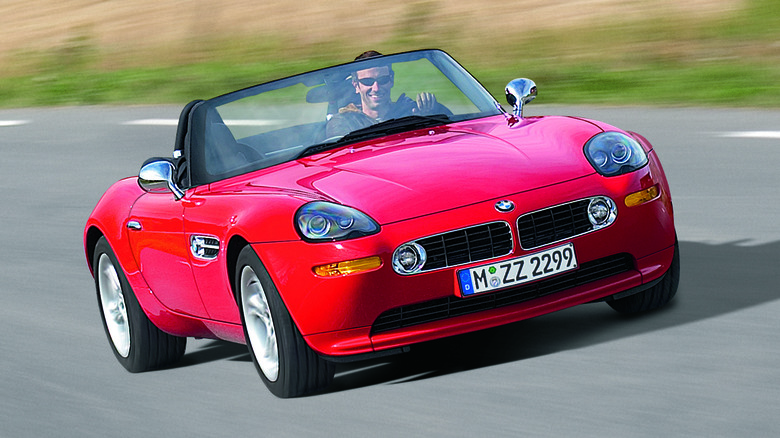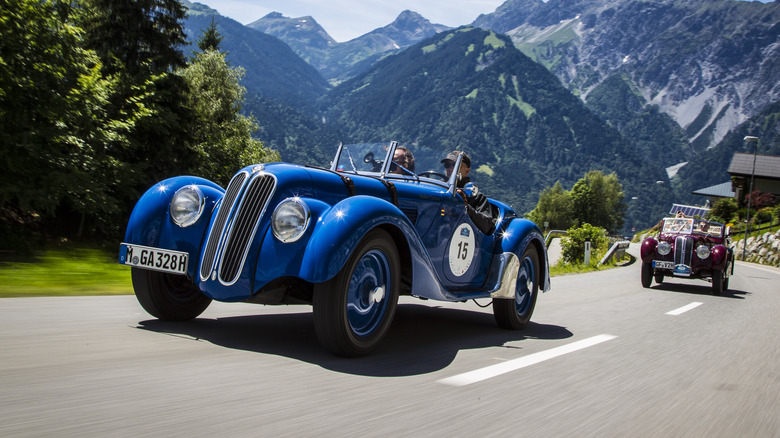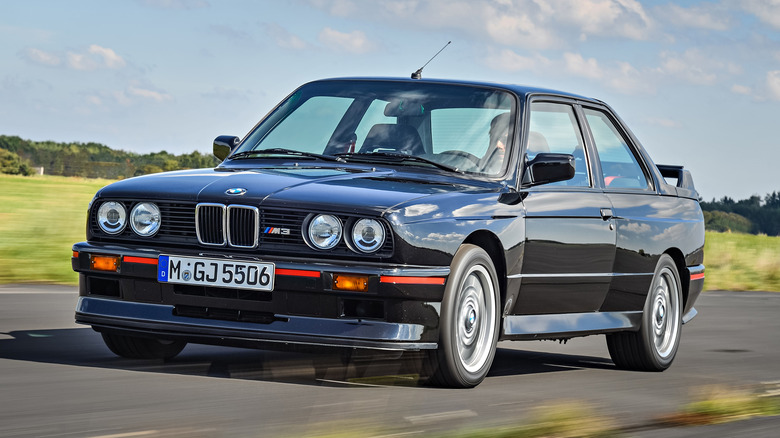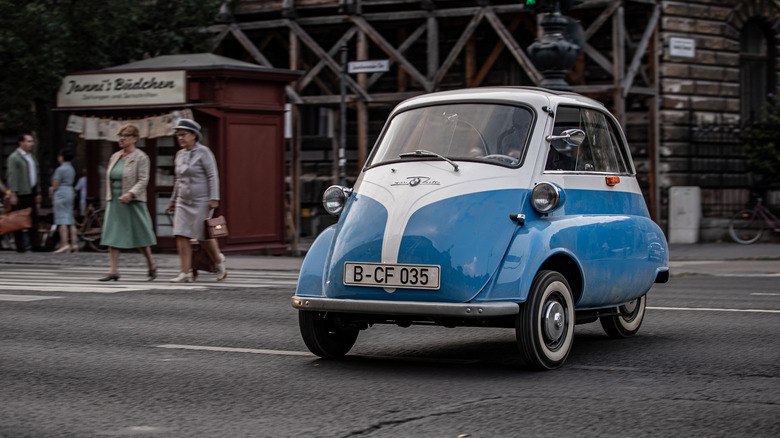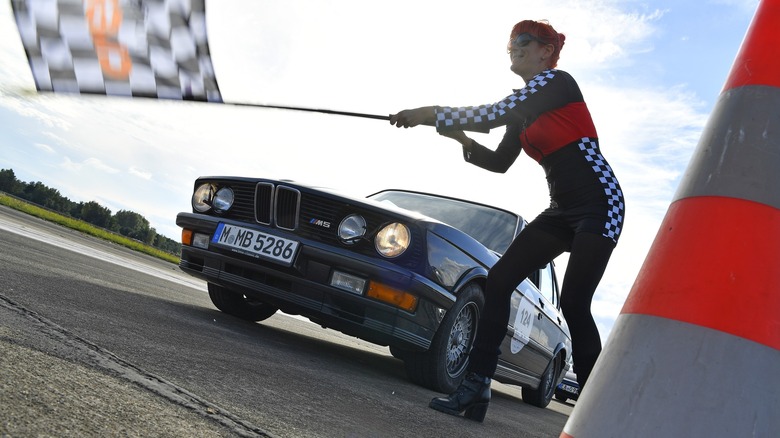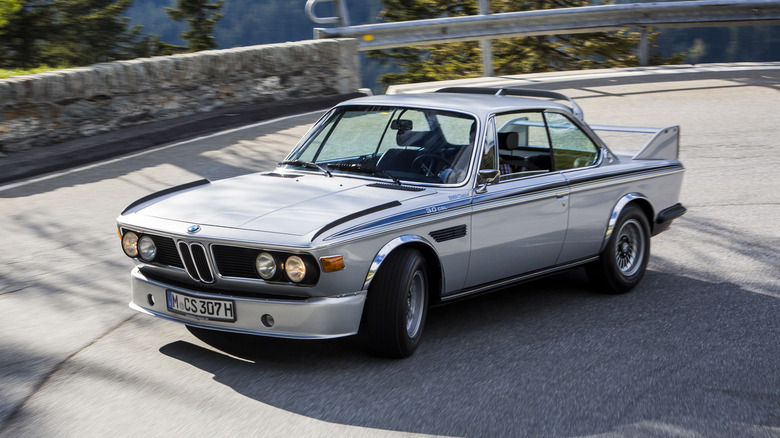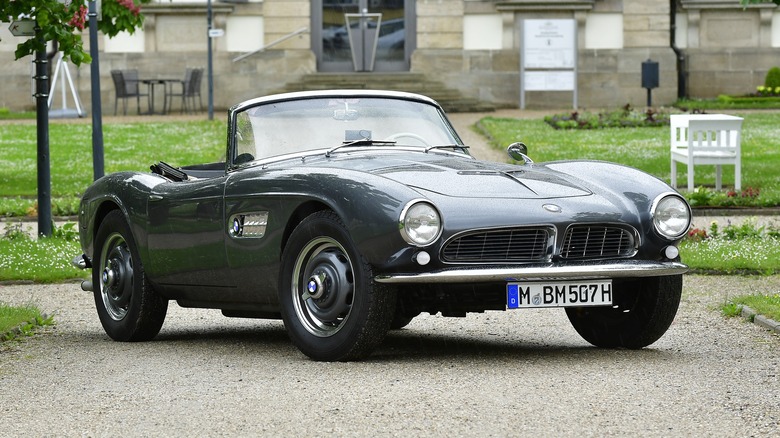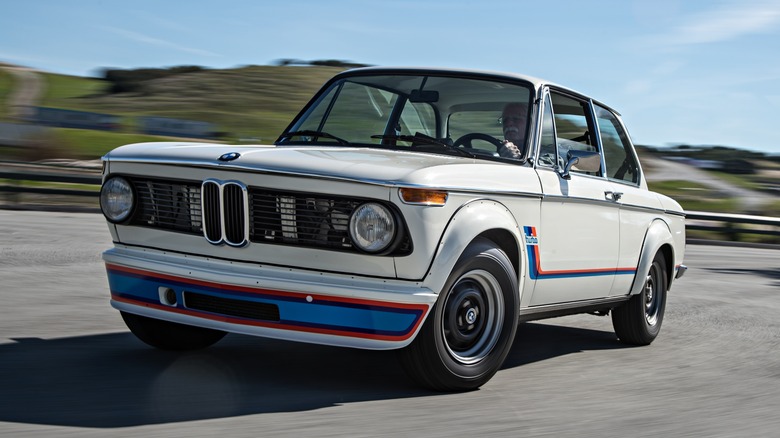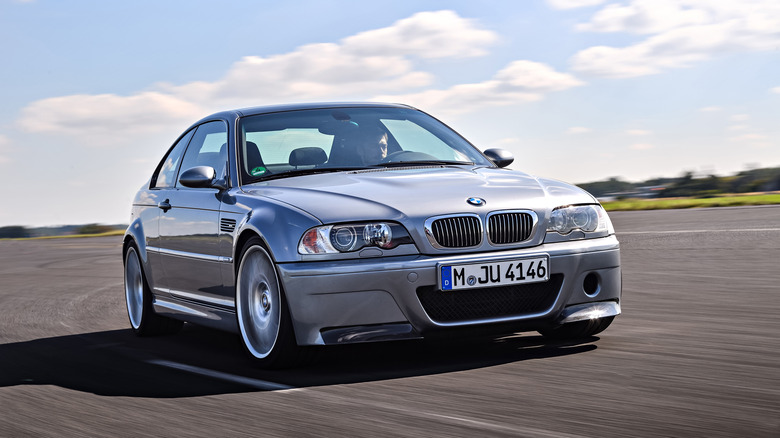10 Of The Most Iconic BMW Cars Ever Made
Any brand that refers to its cars as the "ultimate driving machine" is giving itself a high bar to meet. However, BMW's famous advertising slogan is more than mere marketing jargon. Over the decades, the brand's best cars have set the benchmark for driving dynamics and performance in their respective segments, often while retaining a usability that gives them a leading edge over the competition.
Its bread-and-butter cars can be found on roads across the globe, and at the other end of the spectrum, its most exclusive models spark fierce bidding wars among seasoned collectors at auction. Many of its most iconic cars are of the latter kind, being halo products that represented the very best of what the brand could create at the time of their unveiling. From track-ready sports cars to mass-produced superminis, BMW's back catalog has more than its fair share of icons, and these are among the very best.
BMW M1
The BMW M1 occupies an unusual space in automotive history. It was very influential in shaping future BMWs, but it was also a big commercial flop for the carmaker. Largely, its lack of commercial success was down to the numerous delays that plagued the car's development, threatening to derail the project multiple times. As a result of the M1's development process being both over budget and much lengthier than planned, the car's asking price was also extremely high, further limiting its potential pool of buyers.
The fact that the Bavarian brand even got the car into dealerships at all is an achievement in itself, but it did, and the M1 redefined what a BMW could look like. Its sleek Giugiaro-penned styling turned heads, and its potent 277 horsepower six-cylinder engine made it the fastest German car on the market at the time. Racing versions of the M1 were even faster, with the most extreme iterations producing as much as 1,000 horsepower. Today, the race-spec M1 Procar is one of the most valuable and sought-after BMWs ever built, with examples fetching as much as $1 million on the rare occasion they appear at auction.
Arguably, the M1 is BMW's one and only true supercar, with its closest successor, the i8, never quite offering the same level of performance. As such, it automatically earns its place as one of BMW's most iconic cars, despite the severe financial headache it caused its manufacturer.
BMW Z8
Unveiled in late 1999, the BMW Z8 was designed to be the brand's way of combining the heritage of its 20th Century products with the technology of the 21st Century. It was always intended to be a low-volume sports car, acting as a halo product for the BMW brand. The car's design took inspiration from the classic 507, another iconic BMW that is revered by collectors and enthusiasts today. Its engineering, by contrast, was a firmly modern affair, with BMW using cutting-edge materials and a freshly designed 400 horsepower V8 to give the car the performance to match its looks.
In the U.S., the Z8 started at $128,000, which put it out of reach for all but the wealthiest enthusiasts. Today, values are even higher, in part thanks to the car's low sales figures. Much like the M1, the Z8 was discontinued without a direct successor, and none have emerged in the decades since the last example left the factory. However, the BMW Concept Skytop, a one-off unveiled in May 2024, has given enthusiasts renewed hope that another low-volume halo roadster might eventually be offered by BMW once again.
BMW 328
It might not have been supercharged like its rivals nor boasted an engine with huge displacement, but the BMW 328 proved to be consistently fast in competition. So fast, in fact, that it helped establish the BMW brand as one of the premier European racing automakers, snatching wins against cars that had considerably higher power outputs in the process. It debuted at the largest race of the year at the Nürburgring in 1936, winning the event and breaking the sports car lap record for good measure.
Roadgoing customer versions of the car were launched the following year, with production continuing until non-essential German car manufacturing was halted in 1940. A total of 464 examples of the 328 were built over that period, and thanks to their racing pedigree, they're considered collectors' grails today. The most pristine examples of the car have sold for almost $1 million, making them one of the most valuable BMWs as well as one of the most iconic.
BMW M3 E30
The first iteration of the legendary M3 was never intended to be as successful as it ended up being. Like so many other great cars, it started simply as a homologation special, being designed to meet the regulations to allow BMW to enter Group A racing. Those regulations dictated that at least 5,000 road-going examples of any race car had to be made, and so BMW planned to make exactly that number. However, as soon as the M3 hit dealerships, it became clear to enthusiasts that its race-tweaked engine and light weight made it an excellent road car.
The initial 5,000 unit production run quickly sold out, so BMW extended production, then extended it again in the wake of ever-increasing demand. Eventually, close to 18,000 examples of the M3 E30 would leave the factory. The most powerful iteration of the car produced 238 horsepower from its four-cylinder engine, although most examples made a shade under 200 horsepower. Collectors are willing to pay increasingly eyebrow-raising premiums for the rarest examples, with one ultra-low mileage car selling for $250,000 in 2020.
BMW Isetta
As well as being one of the most unique looking cars to ever emerge from Bavaria, the BMW Isetta is particularly important in the brand's history for an unusual reason. During the '50s, BMW had taken heavy losses developing low-volume roadsters and sports cars, and its finances were looking increasingly dire. The Isetta was a vital way of offsetting some of those losses, being cheap and simple to produce yet ultimately very popular with the German buying public. Over 160,000 examples were made in total, with the profits from the car helping to save BMW from bankruptcy.
The car was unique in several ways, most famously because of its bubble design and front-opening door. Its modest single-cylinder engine was also an unprecedented step from a company that had spent much of its existence chasing racing wins, but it was necessary to keep costs as low as possible. The Isetta design was not created in-house but rather licensed from Italian manufacturer Iso Rivolta, further saving on R&D costs. All these savings could be passed on to the customer, with the Isetta being one of the cheapest cars on the German market at its launch. Thanks to its unique history, it's not so cheap today, with surviving examples fetching $40,000 or more at auction.
BMW M5 E28
It wasn't the first sedan with an M badge — that honor goes to its predecessor, the M535i E12 – but the M5 E28 is arguably the most influential M5 ever built. It was developed with components from the pioneering but ultimately low-selling M1, and shares its engine with the seminal supercar. A few minor tweaks saw the M5's power output reach 286 horsepower, enough for a 0-62 mph time of 6.5 seconds, a figure unheard of for a production sedan at the time.
Add in the car's top speed of 152 mph, and the result was a car faster than most dedicated sports cars, yet with enough room to carry a family and their luggage. This exceptional performance wasn't reflected in the car's exterior design, however — save for the subtle rear wing and M badges, there was little to indicate that the car was quite so powerful. The M5 E28 was one of the early pioneers of sleeper sedan design, an ethos that the modern M5 continues to follow today. Despite its iconic status, the M5 E28 doesn't command the same high resale price as many of its peers today, with examples frequently selling for under $40,000.
BMW 3.0 CSL
Nicknamed "the Batmobile" thanks to its wild body kit, the BMW 3.0 CSL is not only one of the most iconic but also one of the most visually distinctive cars of its era. It's one of a mere handful of BMW cars to bear the revered "CSL" badge, with the latest example being the M4 CSL. The acronym stands for "Coupe Sport Leichtbau," or "Coupe Sport Lightweight" in English, and the 3.0 CSL is the reason that the name carries such weight with BMW enthusiasts in the first place.
The car was exactly what the "CSL" name suggested, being a race-oriented coupe version of the E9 with a sportier engine and lightweight construction. It was built for homologation purposes, and proved to be a success both on the track and with buyers, who were struck by its outlandish design. It remains equally attention grabbing today, and that star power combined with its rarity makes it a comfortable six figure car on today's market.
BMW 507
As arguably one of the most elegant classic roadsters ever built, the BMW 507 was always set to be an icon. It's very rare, too, with around 250 examples built, far under the 5,000 examples the brand was originally expecting to sell. The car's high development costs and extremely low sales figures helped push BMW towards the brink of extinction in the years after its unveiling, stretching the brand's already limited finances near breaking point. Ironically, today the car is one of the most desirable BMWs on the planet, with examples trading for seven figure sums at auction.
It might not have been a big seller, but the few buyers the 507 did find were often high profile. Elvis Presley was among those famous owners, having purchased the car for his collection while stationed in Germany during military service. His car was originally painted white, but after female fans kept leaving lipstick marks on the car, he had it repainted red. Elvis would trade the car in upon his return to America, where it would languish in obscurity for decades until being bought and painstakingly restored by BMW's Classic division. The restored car was unveiled at the 2016 Pebble Beach Concours.
BMW 2002 Turbo
While much of the rest of the Western world — and indeed most other German manufacturers — were preoccupied with the effects of the Oil Crisis in 1973, BMW was busy churning out pioneering sports coupes. The BMW 2002 Turbo was the top-spec variant of the 02, featuring a 170 horsepower four-cylinder engine and some distinctive body modifications including wider wheel arches and a rear wing. Its 131 mph top speed and 7.0 second 0-62 mph time put it in the fastest category of German cars at the time, while the optional M-color striping ensured it was also one of the most attention-grabbing cars to boot.
The car sports all the ingredients of a true enthusiasts' favorite: a lightweight, responsive chassis, a rev-happy engine, and a four- or five-speed manual transmission. Despite the ongoing fuel crisis, that formula made the car a niche hit, ensuring BMW would continue to develop its sports car line even when other manufacturers were focusing on more sober, fuel-efficient models. Today, the car remains just as popular with collectors as it was back then, and values have risen into six-figure territory for pristine examples.
BMW M3 CSL
The "CSL" acronym had already entered the halls of automotive legend by the time the M3 CSL was unveiled in 2003, with the 3.0 CSL setting an extremely high bar for its successor to meet. Thankfully, the M3 CSL delivered exactly what enthusiasts were hoping for: driving thrills, technological firsts, and tire-smoking performance. Just 1,383 examples were built, with BMW targeting a special kind of buyer for this most desirable of special edition cars. Specifically, the brand wanted buyers that were going to use the car to its full potential, unleashing it on track rather than keeping it caged in an air-conditioned garage.
To encourage those buyers, BMW limited the M3 CSL to 155 mph as standard, but allowed each buyer the option of raising the limiter to 174 mph if they could produce a suitable racing license. The 360 horsepower on offer might not seem like a huge amount by today's standards, but it was more than enough to make the M3 CSL a true track weapon. That has helped keep it in high demand among collectors, with low-mileage examples of the car selling for sums over $100,000.
